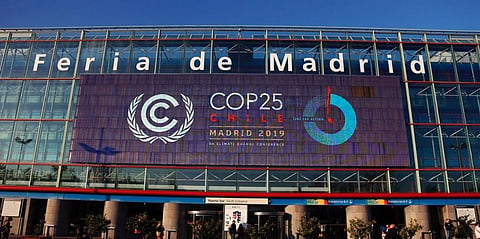

New text has emerged from the largely closed-off negotiating rooms in Madrid on two critical inter-related issues which have threatened to tank the 25th Conference of Parties (COP25) to the United Nations Framework Convention on Climate Change (UNFCCC).
The deadline for targets taken on by developed countries at the Cancun COP 2008, formalised at the Copenhagen COP 2009, is 2020. It is also the deadline for the second commitment period of the Kyoto Protocol (2013-2020). Developed countries’ record on meeting their targets is mixed.
The United States, for example, committed to reduce its emissions by 17 per cent between 2005 and 2020; it is falling short by 2-3 per cent. Canada, with an identical 2020 target was also falling short.
While the European Union and Japan are meeting their targets, their targets are broadly consistent with the developed country norm of taking on targets far below their historic responsibility for climate change. In Japan’s case, it announced a 2020 target in Copenhagen and then revised it drastically downward, rendering its ‘over’-achievement meaningless.
In addition, at Paris, developed countries committed to providing $100 billion in new and additional finance each year for mitigation and adaptation in developing countries. The deadline set to ramp up to this level of annual finance mobilised was 2020. The latest report of the UNFCCC Standing Committee on Finance indicates that the annual amount mobilised is well less than half of that promised.
This underperformance has prompted China and India to hold off consensus on some issues, as well as refuse to commit to raising their domestic mitigation ambition in the future. Article 4 of the Paris Agreement commits countries to submit national targets every five years. New targets need to represent a progression (which should be interpreted as an improvement) over old targets.
The first round of targets came with the Agreement in 2015, the second round is due in 2020. Despite progressively ambitious nationally determined contributions (NDC) being a legal commitment under the Agreement, the coming withdrawal of the US has already reduced the pressure on other countries to raise ambition in their 2020 NDCs.
At COP25, small island and other vulnerable countries are specifically trying to get a decision which commits countries to new targets which aim to keep the globe under 1.5 degree Celsius of end-century warming. China and India’s linking of future ambition with delivery on old ambition has made this an uphill task.
The two pieces of text which have emerged indicate a desire for consensus, but not actual achievement of such consensus. The text on the pre-2020 stocktake offers four options
This is an option focused on progress (or lack thereof) by developed countries, which will be conducted by a technical body. It is likely to be the preferred option of China and India.
This is also focused on progress by developed countries, but the process is more in the control of countries than a technical body. This is less likely to produce a report that comments unfavourably on progress by developed countries (while keeping in mind that all UNFCCC reports, even by ‘independent’ technical bodies, are diplomatic products, which generally do not take a strong tone).
Options 3 and 4 particularly show some potential to break the deadlock, but the retaining of the “no text” option indicates that some developed country negotiators in the room have instructions to not allow this kind of pre-2020 judgment. Nevertheless, the fact that the text has emerged may indicate that previously entrenched positions are softening.
The text on NDCs also contains options: One merely refers to the Paris Decision and Agreement, but the other goes further. It “Calls on Parties to use the opportunity to raise the level of ambition in 2020 in response to the climate urgency and with a view to achieving the long-term goals set out in Article 2 and Article 7, paragraph 1, of the Paris Agreement.”
Article 2 commits countries to hold the “increase in the global average temperature to well below 2°C above pre-industrial levels” and pursue efforts to “limit the temperature increase to 1.5°C above pre-industrial levels”.
In one sense, this is nothing more than a reiteration of a legally binding agreement. However, the fact that current NDCs have the globe on track for well beyond 2°C of warming indicates that legally binding international agreements need to do more than simply state a goal.
A COP decision leading into 2020 that reiterates the need to take the 1.5°C threshold and the climate emergency seriously – as the IPCC has found it should be – would be a significant step toward retaining the integrity of the Agreement.
However, with options still in the texts regarding past and future targets, and with so much linkage across texts, the road to consensus on ambition in Madrid still looks difficult.